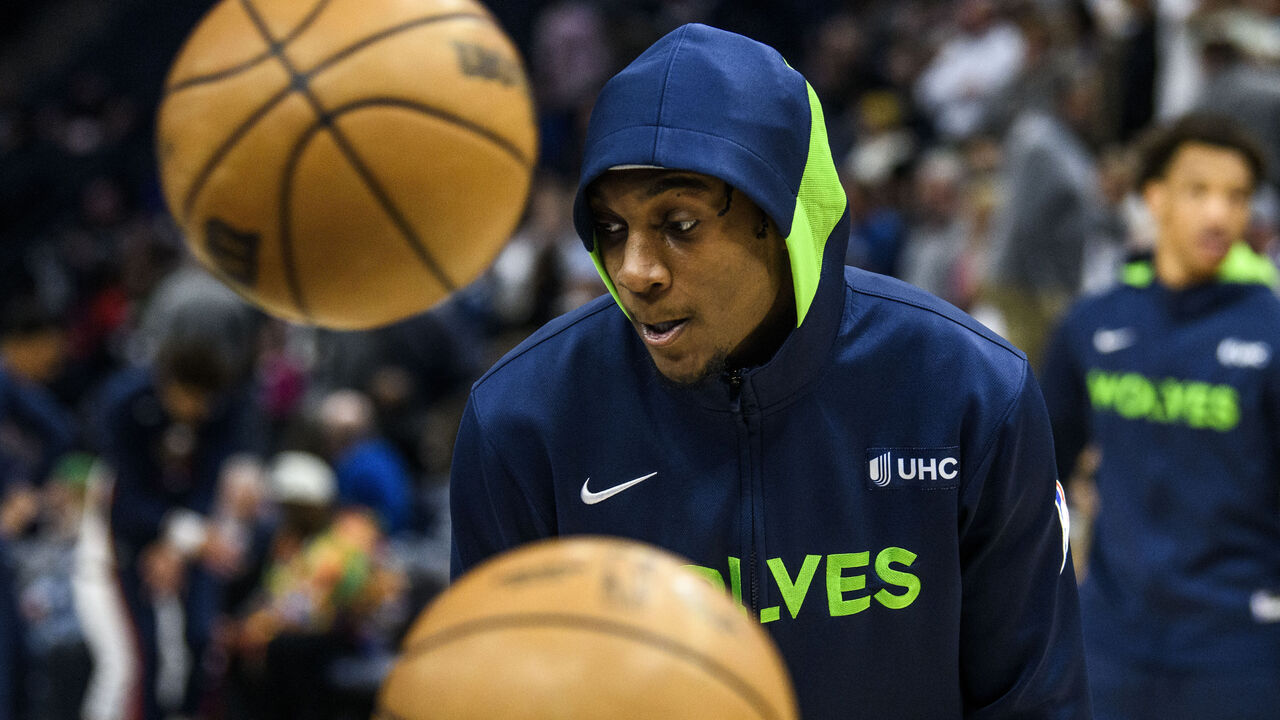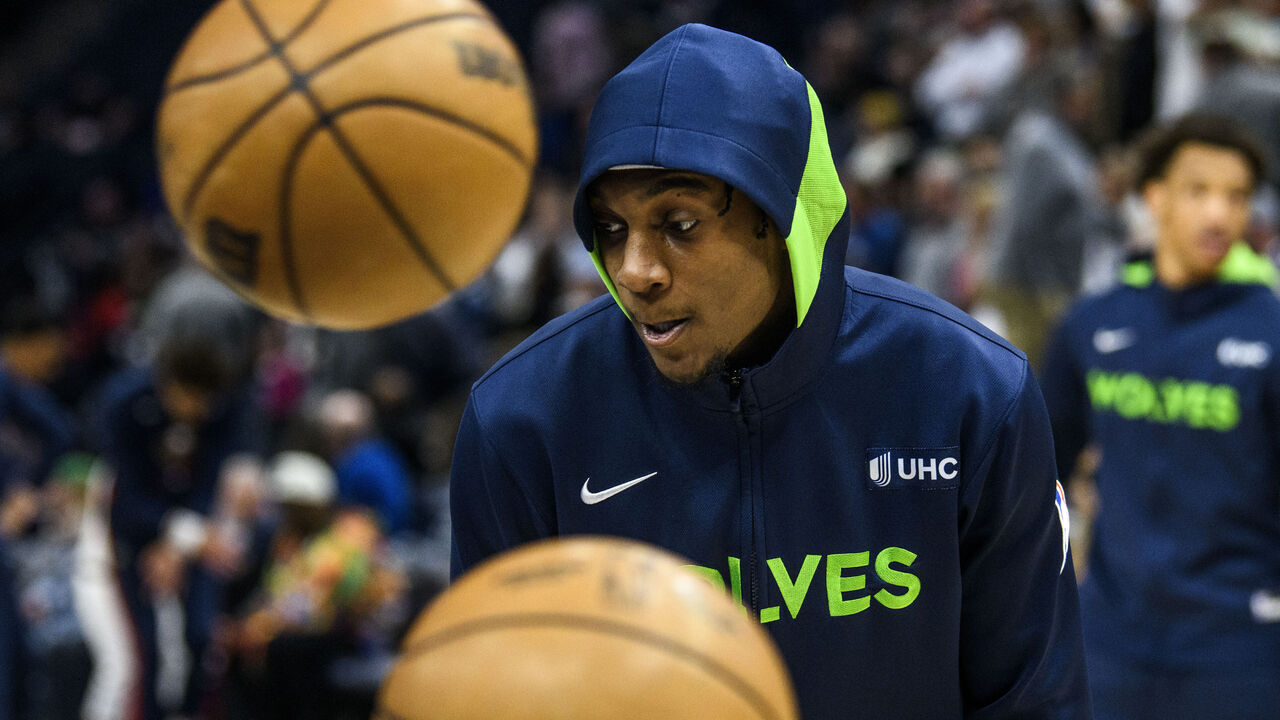The Wolves' road to salvation runs through Jaden McDaniels
With the 2023-24 campaign approaching, we’re diving deep into some of the players we’re most interested in watching. Next up, a defensive unicorn whose untapped offensive potential could change the outlook for a desperate franchise.
Previous entries: Austin Reaves; Victor Wembanyama and Chet Holmgren
Given how much of their future they sacrificed in service to their present-day roster, the Minnesota Timberwolves may have been the most disappointing team in the NBA last season. After shelling out a king’s ransom to acquire Rudy Gobert, they slogged through a season in which injuries and identity crises prevented them from ever finding their footing. Minnesota never climbed more than two games above .500 and appropriately finished exactly there at 42-40. The club lost its first play-in game but won the second to secure the West’s No. 8 seed before the top-seeded Denver Nuggets promptly dispatched it in five games.
Still, for all the damning mediocrity and the irrevocable damage wrought by last summer’s ill-fated blockbuster trade, there are reasons to feel optimistic about the beleaguered franchise’s present and future. The biggest of those reasons is obviously Anthony Edwards, who was included in this list a year ago and proved worthy of the distinction. He took another huge leap toward franchise-carrying superstardom in his age-21 season, carrying the offense during Karl-Anthony Towns’ four-month absence and earning his first All-Star nod before absolutely popping off in the series against Denver. But hiding in Edwards’ shadow was another vital Timberwolves developmental success story: Jaden McDaniels.
Taken 28th overall in the same draft in which Minnesota selected Edwards No. 1, McDaniels blossomed into a two-way force in his third season. He built out his offensive game in 2022-23 while further establishing himself as one of the NBA’s most unique and versatile defenders. The Wolves would throw him at their opponent’s biggest perimeter threat every night, regardless of that player’s size or attacking style. At 6-foot-9, he was somehow one of the league’s premier screen navigators and point-of-attack stoppers, proving every bit as capable of corralling speedy star guards as he was at locking up playmaking wings or providing weak-side rim protection.
No other player can do all those things at the level McDaniels can right now. Last season, he was frequently the primary on the likes of Ja Morant, Tyrese Haliburton, and Trae Young. But he also held opponents to 52.9% shooting at the rim, the eighth-lowest mark among players who defended an average of at least three such shots per game. McDaniels sometimes showcased both abilities on the same possession, hounding a star point guard one second and flying over from the help side to annihilate a layup attempt the next:
McDaniels narrowly missed out on All-Defensive honors (he was the second-to-last cut after Giannis Antetokounmpo) and was arguably the biggest reason the Wolves, amid all their dysfunction, maintained a top-10 defense for most of the season. He affords them the flexibility to play any style. The 22-year-old can be the chaser in a drop-back scheme, anchor back-line rotations in a blitzing scheme, hold his own in any matchup within a switch-everything scheme, and wreak havoc at the top or base of a zone.
But we already knew McDaniels had the potential to be a special defender. And while it was thrilling to see him actualize that potential so early in his career, the strides he made at the other end of the floor felt equally (if not more) important. McDaniels has already shown enough growth to transcend the defensive-specialist mold. From here, the extent to which he can build on that growth will determine whether he ascends into the stratum of stars. It’ll also help determine how much better Minnesota’s offense – which tumbled from sixth in the season before the Gobert trade to 23rd last campaign – can be in 2023-24.
McDaniels made something of an offensive mini-leap last season. He didn’t blow up in any one area but made modest gains across the board. At 15.8%, his usage rate barely budged, and he remained firmly in role-player territory. However, McDaniels improved his handle, dribble-drive game, and in-between scoring counters to the point that Minnesota could run the odd possession through him and trust him not only to attack off the catch but to create for himself from a standstill. Opponents often tried to hide their weakest defender on him, and he got pretty adept at punishing those matchups.
It also helped that he shot a career-high 39.8% from 3-point range, which made him a more dangerous off-ball threat and allowed him to tap into his burgeoning off-the-bounce game as a closeout attacker. McDaniels was already a strong interior finisher with superb cutting instincts, so his shooting bump and increased comfort with the ball in his hands turned him into a highly efficient (albeit still low-volume) all-around scorer, resulting in 12.1 points per game on 61% true shooting. Can he find a way to do more while maintaining that efficiency?

The 3-point shot is something to watch because a good deal of his value hinges on that swing skill, and it’s been a volatile one for him through his first three seasons. McDaniels has attempted 719 threes over his career – right around the point at which percentages start to stabilize – and hit a respectable 36% of them. To this point, the vast majority of those have been stationary catch-and-shoots. He hasn’t demonstrated much aptitude for shooting on the move. That lack of shooting versatility, coupled with a slow release, depresses McDaniels’ 3-point volume and mitigates the spacing he can provide even when he proves capable of canning 40% of his long balls.
For now, the Wolves seem committed to pressing forward with their tall-ball identity and leaning into two-big lineups with some combination of Gobert, Towns, and Naz Reid. That plays to McDaniels’ strengths defensively but makes his road to a full-fledged offensive breakout a bit more complicated. Earning more touches will be a challenge regardless, with more established creators around him in Edwards, Towns, and Mike Conley. Being on the floor with two big men makes it that much more difficult to run plays for him or involve him in central actions unless he’s the ball-handler. Putting the ball in his hands is tough to justify when Edwards or Conley is on the floor.
It’ll be interesting to see how or if McDaniels can make a case to shoulder a larger share of the offensive responsibilities within that constricting framework, especially with restricted free agency looming (assuming he doesn’t get extended this offseason). He’ll invariably get relegated to spot-up or scavenging duty a lot of the time. But even in that role, there will be opportunities to assert himself more forcefully as a play finisher and connective playmaker.
One also hopes McDaniels will get to demonstrate how his refinements carry over to the playoffs next time around. He didn’t get to do that this year because he broke his hand punching a wall in frustration during the last game of the regular season and missed the playoffs. His presence likely wouldn’t have changed the outcome of the series against the Nuggets, but it certainly would’ve made things more interesting and given the Wolves a better chance to keep a lid on Jamal Murray. As it was, they gave Denver a decently competitive five-gamer after very nearly stealing the 7-seed from the Los Angeles Lakers in the first play-in.
The magnitude of last season’s disappointment relative to expectations overshadowed the fact that Minnesota still has a young foundation with plenty of room to grow. McDaniels is a central pillar of that foundation, and the team’s ability to make last summer’s all-in push pay off rests with him nearly as much as it does with Edwards or Towns. He actually feels like a much more entrenched piece of the Wolves’ future than Towns does at this point. It wouldn’t be a surprise to see the front office trade the 2016 Rookie of the Year in a roster-rebalancing move that broadens McDaniels’ offensive role while pushing him back up to the four on a full-time basis.
One way or another, McDaniels is probably the biggest X-factor for a team that, despite its youth, has as much riding on the coming season as almost anyone in the league. And that makes him one of this year’s most interesting players to watch.


